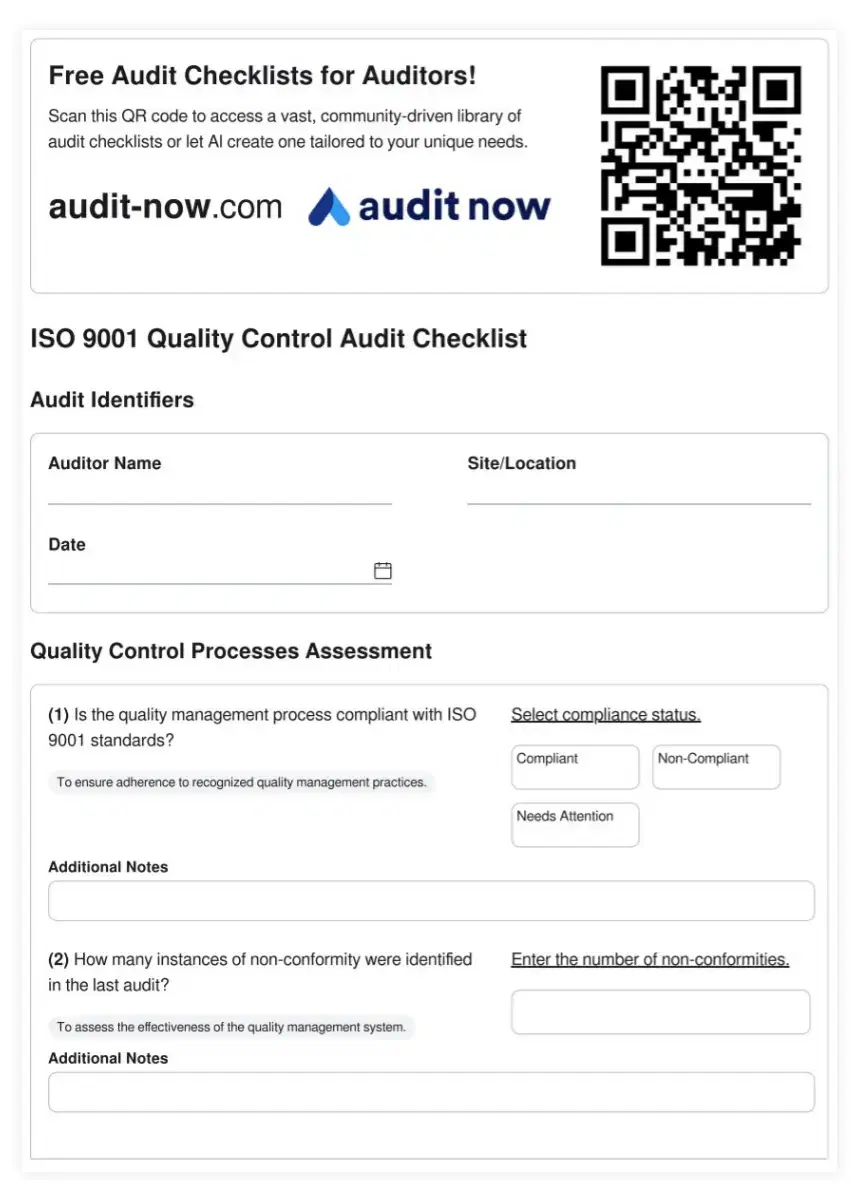Ensuring food safety is vital for every restaurant, as it protects customers and preserves your reputation. A well-structured HACCP plan, supported by Audit Now’s digital tools, helps restaurants manage hazards, maintain compliance, and build lasting trust.
19 Sep 2025
•
Beril Işık

Featured Checklist

Food Safety and HACCP Audit Checklist
A Food Safety and HACCP Audit Checklist is an essential tool for ensuring compliance with food safety regulations and HACCP principles. This comprehensive checklist helps food businesses identify potential hazards, implement critical control points, and maintain high standards of hygiene and safety throughout the food production process. By systematically addressing key areas such as personal hygiene, temperature control, and cross-contamination prevention, this checklist enables auditors to thoroughly assess and improve food safety practices, ultimately protecting consumers and reducing the risk of foodborne illnesses.
Food safety is the foundation of every successful restaurant. While great recipes attract customers, it’s the promise of safety that keeps them coming back.
A HACCP plan for restaurants ensures staff identify check, and control food hazards. This protects customers, strengthens compliance, and builds long-term trust.
Audit Now makes managing HACCP plans easier than ever. It has customizable digital checklists, automated monitoring, and centralized record-keeping.
The Hazard Analysis Critical Control Point (HACCP) method is important for food safety. It helps restaurants identify, check, and control biological, chemical, and physical hazards.
Audit Now integrates with all these principles in one platform. It offers digital checklists, automated monitoring, and centralized documentation. So that HACCP implementation can be more efficient and reliable.
Simplify your food safety management with Audit Now’s digital checklists
Start Now
A HACCP plan is more than a legal responsibility. It’s a practical framework for protecting diners and ensuring consistent operations. Foodborne illness is one of the biggest risks in the hospitality industry. Even a single incident can damage a restaurant’s reputation or force closure.
Protecting customers from foodborne illnesses
Health inspections review various aspects of restaurant operations. They include food handling, staff hygiene, equipment compliance. The process also involves temperature control, pest prevention, and HACCP procedure compliance.
Maintaining accurate and up-to-date records is a cornerstone of an effective HACCP plan. Restaurants can track compliance with food safety procedures with proper documentation. So that they can be ready during health inspections. Organized records provide transparency, accountability. They also act like a clear trail of actions taken to prevent food safety risks.
Restaurants should maintain:
Audit Now organizes these records digitally, making inspection readiness simple and reliable.
Internal audits allow restaurants to assess compliance, take corrective measures. So that they can and strengthen food safety monitoring. With Audit Now’s digital checklists, internal audits become streamlined. They reduce human error and save time.
A HACCP plan provides a clear operational framework. This improves staff consistency at critical control points. It also defines processes for daily efficiency. Staff can catch hazards earlier, reducing waste and minimizing inspection risks.
Restaurants using strong food safety practices also build trust with diners. This encourages repeat business and positive reviews. This is particularly important when serving vulnerable populations. The population may include children, the elderly, or those with food sensitivities.
For a comprehensive HACCP plan to be effective, some things should be complete. Staff should understand and follow it consistently.
Proper training ensures that every team member knows how to identify hazards. Once they identify, they need to use critical control measures. So that they can maintain high standards of food safety.
HACCP training equips staff with the knowledge they need for ensure food safety. This is valid for every step of restaurant operations. In this training, employees learn to perform risk analysis and identify potential hazards.
The hazards include microbial risks such as salmonella and listeria. They also recognize critical points and thresholds where they need to control. Training also emphasizes ingredient traceability and reinforces proper handling, storage.
Effective HACCP training guides employees to recognize common hazards in the kitchen. Once they know they can follow critical control point procedures. Staff learn to record monitoring data. They also report any issues immediately. This is to ensure that the staff address potential risks before they affect food safety. During these trainings, they combine clear guidance with practical exercises. It ensures that team members can contribute to maintaining a safe kitchen environment.
Audit Now supports training through step-by-step digital workflows. This reduces mistakes and shortens learning periods. The staff can make updates within minutes and hours. It helps a lot when menus, equipment, or regulations change.
Digital solutions are essential for efficient HACCP implementation. Traditional paper-based systems are prone to errors and inefficiency. Audit Now offers:
Advanced features include automated temperature logging with alerts. There is also AI-driven predictive insights for hazard prevention, multi-location management. The multi-location management feature allows automatic compliance updates. These tools save time, reduce errors. They ensure restaurants maintain current food safety standards.
Customer expectations and regulatory requirements are evolving. Transparency and automation are becoming important day by day. Audit Now provides:
Restaurants leveraging digital HACCP solutions gain competitive advantages through reduced inspection violations. They can improve customer confidence, enhance operational efficiency, and empower staff.
A HACCP plan for restaurant operations is essential for ensuring compliance. So that they can protect customers and build trust. HACCP helps restaurants operate safe and efficient. The process include all steps: Hazard identification, staff training and inspection preparation,
Audit Now streamlines the process with digital checklists, automated monitoring, and centralized records. Implementing a HACCP plan supported by Audit Now ensures compliance today. It strengthens customer trust, and positions your restaurant for long-term success.
Audit Best Practices: Learn More
What Does a Restaurant Manager Do? Key Responsibilities and Best Practices
The Complete Guide to Restaurant Inventory Management in 2025